The last week has been exciting for this backyard farmer, and there is much to report, so today you get two blog posts for the price of one. Lucky you, loyal reader.
First, an update on the ladies…
This weekend, the chickens moved out of the basement and into their coop! After I put down some paving stones on Saturday to keep any nocturnal predators from digging under and having themselves a midnight snack, the girls spent their first full day and night in the coop. At just over five weeks old, they are almost fully feathered out. Still, the evenings here in Northern California are pretty chilly if you happen to be an adolescent bird, so we’ve had to pay close attention to nightime temperatures. To keep the birds warm, we ran the heat lamp out to the coop with a reeeeeally long extension cord. All went well that first night, both in terms of security and tempurature control.
However, keeping livestock in an urban residential neighborhood is bound to draw some attention from the neighbors, especially if you are lighting them up at night with a bright red heat bulb. Apparently, our next door neighbors, who are slightly bothered by the chickens, are even more bothered by the heat lamp. The danger here, of course, is that the lamp, which was very securely and safely affixed to a bar in the coop, would somehow set the coop on fire. That fire would then scale the metal fence that separates our yards, traverse the 10 to 12 feet of concrete between the fence and her car, ignite the gas tank, and blow us all up in the middle of the night. Noted.
To keep the neighbors happy (or at least less unhappy), we removed the heat lamp after the first night. As the sun went down on Sunday, the air temperature felt particularly chilly, and I couldn’t stand knowing that the birds would have to bear it through the night. So, back in the basement they went, a little grumpy at being back in their brooder, but warm enough for both them and me to get some sleep.
Monday night, however, was noticably warmer, and we decided to test their feathers. I had to move them one by one into the inside of the coop–or “the condo” as we like to call it–and close the inner door to be sure to keep out any draft (don’t worry, it’s well ventilated). I also gave them a little food and water in case they needed it through the night. I checked on them at 10PM and again before I went to bed at 11:30PM. Roxy, the little one, was snuggling with the bigger birds for body heat, but they didn’t seem at all distressed or unhappy. Then, I set the alarm for 6AM.
After a restless night dreaming of birds and bees, I got up before dawn and went out to the coop with flashlight in hand. All the birds were exactly as they had been the night before. They were sleeping soundly when I crept up on them, and only seemed bothered by the bright light in their little birdie faces. I opened the internal coop door, hoping they would find their own way out when they were ready, and went back to bed. When I came back out at 8:30AM, they were all up and about, clucking and pecking. However, despite the open door, they hadn’t quite figured out that they could leave the condo. So, I chased them down the chicken ladder into the larger run, where they all sat for a befuddled moment wondering how they got there. What do you expect? They’re chickens. I’m hoping that with a little repetition and gentle prodding, they will figure out how to put themselves to bed by the end of the week.
Tuesday night again was a bit too cold, and so we moved the girls back into the basement. Tonight we’re try a plain light bulb in the coop itself and see if that appeases both birds and neighbors.
Here are some photos of the ladies in their new home…
And now for a bee update…
On Sunday, I took an all-day beginning beekeeping class offered by the Oakland-based Institute of Urban Homesteading. I highly recommend the class for anyone in the area who is thinking about becoming an amateur apiarist. The first half of the day we learned about bee anatomy, behavior, social structure and the basics of starting and maintaining your own hive. The second half of the day, we donned the appropriate protective gear and got some hands-on time with the busy little bees themselves. We even had the rare pleasure of witnessing first-hand the installation of a bee package into a new hive.
For those who’ve never seen a package of honeybees, it is a pretty amazing thing in and of itself. It is a small mesh and wooden box–a little over a foot long by about eight inches high, and roughly five inches deep–containing 3 pounds of bees (roughly 10,000 individuals), a can of syrup for sustanance, and a small wooden cage holding one fertilized queen bee and often some attendants to make sure she makes it through the journey safe and sound.
Seeing the package installed was a special treat, particularly since our upstairs neighbors had ordered our package over the winter, and I knew it would only be a matter of time until we had to perform an installation of our own. We were told our package would arrive “sometime in the spring.” As it turned out, approximately two hours after I got home from my class, we got the call that the bees were ready for pick-up. Our neighbor bravely brought the box of bees home in the back seat of her car, and they spent Sunday night down in the basement, about six feet from the chickens in their brooder.
On Monday, I took my conference calls from home, and spent the rest of the day playing with bees. The installation went remarkably smoothly. I made sure to get everything in order beforehand to avoid any mid-installation hiccups. (I believe it was Benjamin Franklin who said, “By failing to prepare, you are preparing to fail.” Noted.) Then, I covered myself from head to toe, lit the smoker, and got to it. Basically, installing a package of honeybees entails removing the can of feed, retrieving the queen and affixing her and her cage to the inside of the hive, and then shaking 10,000 increasingly agitated honeybees from a small box into a bigger box. The pictures below show some of the different stages of the process.
There she is in all her queenly glory.
After the initial shaking, during which most of the bees fell gently into their new home, I left the package upside down on the open hive, so the others could take their time making the transition. After a couple of hours, all but a (relative) few stragglers had made their way into the hive, so I closed it up and put the open package near the entrance in hopes that the rest of them would figure it out for themselves. When I checked on them just before sundown, the package was empty and the only evidence that bees had been installed, were five or six individuals hovering around the front of the hive, presumably making sure that the coast was clear to start building their civilization.
We’ll check on the queen in the next few days to make sure she made it out of her cage and is happily going about her queenly duty of propagating her colony. After that, we will check on the progress of the hive every two to three weeks to be sure that everything is going and growing ok until the honey harvest in the late summer/early fall. Unfortunately, one more thing I learned in my beginning beekeeping class is that there are so many beekeepers in my immediate neighborhood that the likelihood of getting a great deal of honey out of our hive is probably pretty slim. Ugh. Noted.
Long live the Queen!
2 Comments so far
Leave a comment
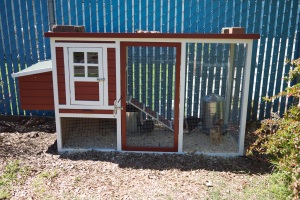
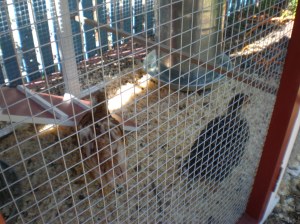
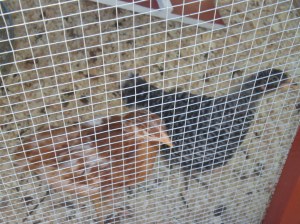
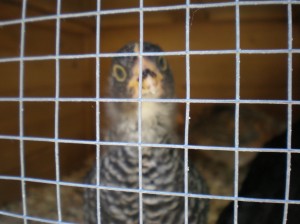
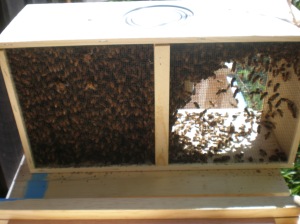
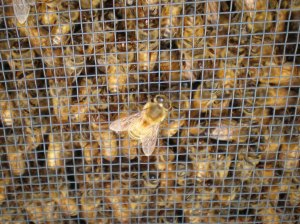
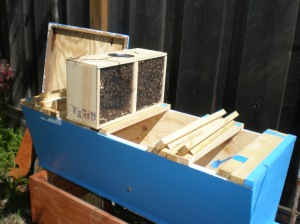
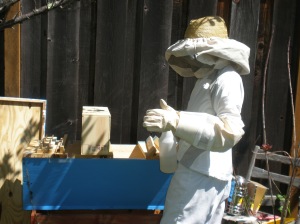
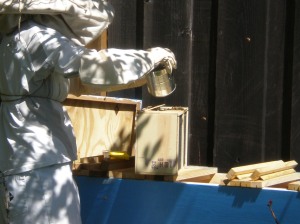
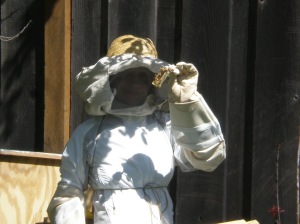
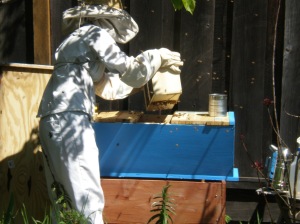
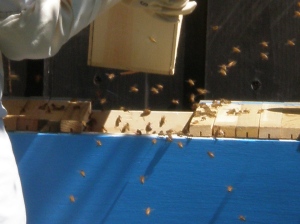
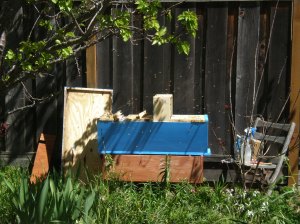
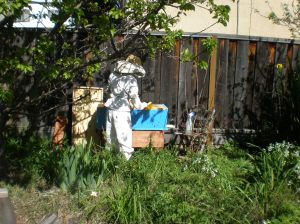
We’ve considered getting a ceramic heating bulb to replace our red one. Its available at most pet stores for ~$20-30.
Comment by gary! April 7, 2011 @ 2:48 pmThanks, Gary! The plain old bulb seemed to work ok last night. I checked on them a couple of times through the night and they were comfortable, though maybe not sleeping as soundly as if it were dark or red in there. We did try to give them some shady areas for better snoozability, but, you know, they’re chickens and they didn’t quite get that. The good news is they all came down the ladder themselves this morning after I opened the coop door, so they’re learning.
I also caught a possum snooping around the coop last night. They’re in there pretty securely, though, so I don’t think there is any reason to be concerned. Beady-eyed little bugger!
Comment by nikkidori April 7, 2011 @ 6:26 pm